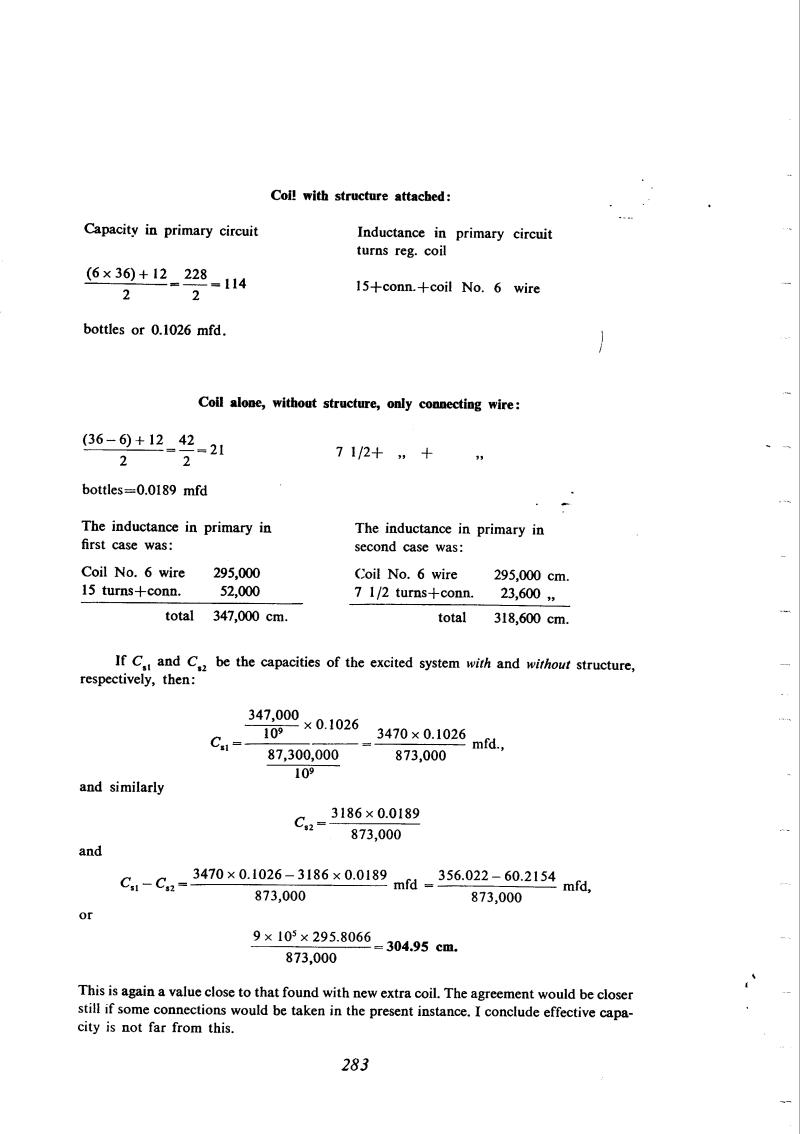
Nikola Tesla Books
| Coil with structure attached: | |
| Capacity in primary circuit | Inductance in primary circuit turns reg. coil |
| $! {{\left({6 \times 36}\right) + 12} \over 2} $! = $! {228 \over 2} $! = 114 bottles or 0.1026 mfd. |
15 + conn. + coil No. 6 wire |
| Coil alone, without structure, only connecting wire: | |
| $! {{\left({36 - 6}\right) + 12} \over 2} $! = $! {42 \over 2} $! = 21 bottles = 0.0189 mfd |
7 1/2 + " + " |
| The inductance in primary in first case was: | The inductance in primary in second case was: | |||
| Coil No. 6 wire | 295,000 | Coil No. 6 wire | 295,000 cm. | |
| 15 turns+conn. | 52,000 | 7 1/2 turns + conn. | 23,600 " | |
| total | 347,000 cm. | total | 318,600 cm. | |
If Cs1 and Cs2 be the capacities of the excited system with and without structure, respectively, then:
Cs1 = $! {{{347,000 \over 10^{9}} \times 0.1026} \over {87,300,00 \over 10^{9}}} $! = $! {{3470 \times 0.1026} \over 873,000} $! mfd.,
and similarly
Cs2 = $! {{3186 \times 0.0189} \over 873,000} $!
and
Cs1 - Cs2 = $! {{3470 \times 0.1026 - 3186 \times 0.0189} \over 873,000} $! mfd = $! {{356.022 - 60.2154} \over 873,000} $! mfd,
or
$! {{9 \times 10^{5} \times 295.8066} \over 873,000} $! = 304.95 cm.
This is again a value close to that found with new extra coil. The agreement would be closer still if some connections would be taken in the present instance. I conclude effective capacity is not far from this.
283
November 12
Measurements of the pole capacity, like those of November 7th, but now using a coil with 1314 turns. Resonance was determined by means of a small lamp in series with a coil loosely coupled to the measuring circuit. The value obtained was again similar, so Tesla concludes that it is near the true value of the effective capacity.
November 12-13
He repeats the structure capacitance measurements, similar to those of Nov. 7, but now he uses the coil with 1314 turns. He determines the resonance by means of a small bulb connected to the coil weakly coupled with rhe measurement circuit. This time as well, he obtained the similar value, and draws the conclusion that he is close to the correct value for effective capacitance. On Nov. 13 he improves the method of determining the moment of resonance (the small bulb he puts in a dark cell in order to be more precise in determining when it starts to glow) and again he determines the capacitance of the structure made out of metal pipes. A change in oscillator frequency is achieved by inductance variation. Now he obtained approximately 10% less structure capacitance in relationship to the previous measurements (please see Nov. 7 and 12).

